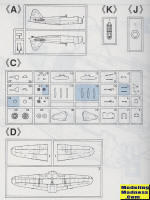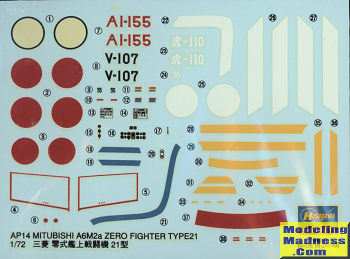
| KIT #: | 51314 (AP14) |
| PRICE: | 500 yen when new |
| DECALS: | options |
| REVIEWER: | Scott Van Aken |
| NOTES: | 1993 release |

| HISTORY |
After the delivery of the 65th aircraft, which were all basically land based, a further change was worked into the production lines, which introduced folding wingtips to allow them to fit on aircraft carriers. The resulting Model 21 would become one of the most produced versions early in the war. A feature was the improved range with 520 l (140 US gal) wing tank and 320 l (85 US gal) drop tank. When the lines switched to updated models, 740 Model 21s had been completed by Mitsubishi, and another 800 by Nakajima. Two other versions of the Model 21 were built in small numbers, the Nakajima-built A6M2-N "Rufe" floatplane (based on the Model 11 with a slightly modified tail), and the A6M2-K two-seat trainer of which a total of 508 were built by Hitachi and the Sasebo Naval Air Arsenal.
| THE KIT |
 When
Hasegawa released its 1/72 second-generation A6M kits in 1993, they provided
kits of the Type 11,21,22, and 32 at about the same time. These all replaced
their earlier toolings from the early 1970s. These new kits were completely up
to modern standards with engraved panel lines, a fair cockpit and they were
accurate in shape.
When
Hasegawa released its 1/72 second-generation A6M kits in 1993, they provided
kits of the Type 11,21,22, and 32 at about the same time. These all replaced
their earlier toolings from the early 1970s. These new kits were completely up
to modern standards with engraved panel lines, a fair cockpit and they were
accurate in shape.
Typical of 1/72 kits of the day, and even those newly tooled, decals were used for the instrument panel. There is no sidewall detail and one can install the cockpit after the fuselage halves have been put together. The upper forward fusealge is an insert and this is probably the most fussy fitting part of the kit.
A nice engine is provided though it does not have pushrod housings and it is something that the modeler might want to add. A single piece cowling has an insert for the lower oil cooler intake and the exhaust stubs are butt joined to the cowling. Prop has separate blades. Once the wing is assembled, this along with the engine, cowling, and tailplanes an be attached. Next the interior head rest and external aileron balances can be attached. The rest of the construction concerns the landing gear, gear doors, drop tank, tail hook and the canopy.
 Instructions
have the usual Gunze paint references and three markings options. Two are in the
overall ight grey scheme as flown by Sigeru Itaya as shown on the box art and
Saburo Sakai with the Tainan Flying Group (code V-107). Note that since this kit was
released, research has shown that the color of these planes was not a light grey
by a more khaki shade called Ame-iro. This shade is now available in several
paint lines and should be used instead of light grey. The third option is one of
the 261st Flying Group with a field applied dark green over the base shade. This
one was operating in the South Pacific (Rabaul/New Guinea). Note that often
times the radio masts were removed along with the radios as Japanese electronics
of the day did got get along well with hot and humid climates. The decal sheet
is very nicely done and surprising for the period, the white areas are actually
white and not the usual off-white.
Instructions
have the usual Gunze paint references and three markings options. Two are in the
overall ight grey scheme as flown by Sigeru Itaya as shown on the box art and
Saburo Sakai with the Tainan Flying Group (code V-107). Note that since this kit was
released, research has shown that the color of these planes was not a light grey
by a more khaki shade called Ame-iro. This shade is now available in several
paint lines and should be used instead of light grey. The third option is one of
the 261st Flying Group with a field applied dark green over the base shade. This
one was operating in the South Pacific (Rabaul/New Guinea). Note that often
times the radio masts were removed along with the radios as Japanese electronics
of the day did got get along well with hot and humid climates. The decal sheet
is very nicely done and surprising for the period, the white areas are actually
white and not the usual off-white.
| CONCLUSIONS |
Since the release of this series of kits, Tamiya and others have produced their own 1/72 A6M kits, yet these still build into very nice models. I've built several of these over the years and have been pleased with the results of every build. Well worth picking up.
| REFERENCES |
https://en.wikipedia.org/wiki/Mitsubishi_A6M_Zero#A6M2b_Type_0_Model_21
June 2022
Copyright ModelingMadness.com. All rights reserved. No reproduction in
part or in whole without express permission from the editor.
If you would like your product reviewed fairly and fairly quickly, please
contact
the editor or see other details in the
Note to
Contributors. Back to the Main Page
Back to the Review
Index Page
Back to the Previews Index Page